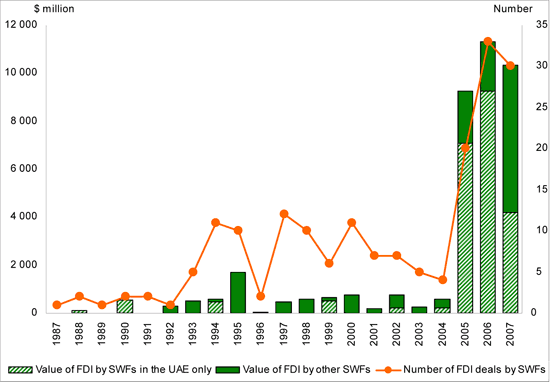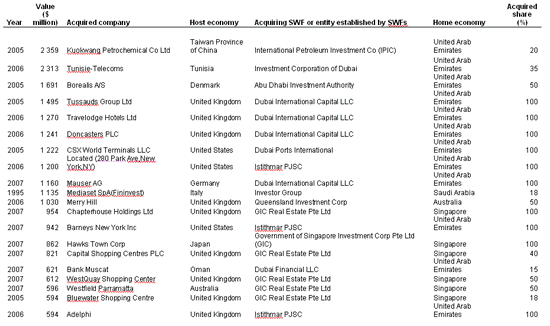| EMBARGO The contents of this press release and the related Report must not be quoted or summarized in the print, broadcast or electronic media before 24 September 2008, 17:00 GMT (13:00 New York, 19:00 Geneva, 22:30 New Delhi, 02:00 - 25 September in Tokyo) |
Geneva, 24 September 2008 - Sovereign wealth funds (SWFs) -- which have accumulated reserves rapidly in recent years and now manage assets estimated at US$ 5 trillion -- are increasingly fuelling large-scale cross-border mergers and acquisitions (M&As) and lately have injected large amounts of capital into several troubled financial institutions in developed countries. The activities by SWFs, which are based mainly in developing countries, are reviewed in UNCTAD´s upcoming World Investment Report 2008(1) . According to data released in advance of the report, these funds are increasingly directed towards foreign direct investment (FDI).
Sovereign wealth funds are special investment funds, created by some governments as far back as the 1950s, for the purpose of holding foreign assets. They tend to have a higher risk tolerance and to expect higher returns than traditional official reserves managed by monetary authorities.
The number of cross-border mergers and acquisitions involving SWFs increased from one in 1987 to 30 in 2007. These recent ventures have been driven by various market trends, the rapid build-up of reserves generated by export surpluses, changes in global economic fundamentals, and new investment opportunities involving structurally weakened financial firms, the report says.
For example, in 2005, IPIC (United Arab Emirates) acquired Kuokwang Petrochemical Co Ltd (Taiwan Province of China) for US$ 2.4 billion - the largest ever cross-border deal by an SWF (table I). IPIC has also announced its intention to invest US$ 0.8 billion in a 20% stake in Cosmo Oil (Japan). In financial services, Temasek Holdings of Singapore acquired a 12% stake in the British bank Standard Chartered. Examples of FDI by SWFs in other industries include investments in telecommunications in Tunisia and plastics in Denmark and Germany (table 1).
While SWFs invest very little in the form of FDI (only 0.2% of their total assets in 2007) this form of investment has been growing: of the US$ 39 billion that sovereign wealth funds have invested abroad over the past two decades, as much as US$ 31 billion of that total was committed in the past three years (figure 1). Examples of SWFs that have invested abroad are the Abu Dhabi Investment Authority, China Investment Corporation (CIC), Kuwait Investment Authority, and GIC fund and Temasek from Singapore.
Over the past two decades, 73% of the foreign investment by SWFs has been in developed countries. As of 2007, SWFs had invested US$ 10.5 billion, or 27% or their total FDI, in developing countries, especially in Asia, with investments concentrated in services, mainly business services. FDI in Africa and Latin America has been very limited so far.
Recent portfolio investments by SWFs have targeted financial services in developed countries. For example, CIC invested US $5 billion in Morgan Stanley (United States); Abu Dhabi Investment Authority acquired a US$ 7.5 billion stake in Citigroup (United States); KIC (Republic of Korea) - together with Kuwait Investment Authority - invested US$ 5.4 billion for an equity capital stake in Merrill Lynch (United States); and GIC fund acquired a US$ 9.8 billion stake in UBS (Switzerland). SWFs also acquired significant shares in selected private equity and hedge funds in 2007, as illustrated by the acquisition of a 9.9% stake in Blackstone (United States) by CIC, and a 9% share of Apollo (United States) by Abu Dhabi Investment Authority. This may indicate an increase in joint deals among these various investor groups in the future.
Although investments by SWFs in the banking industry in 2006-2007 were generally welcomed, owing to their stabilizing effect on financial markets, they also generated some negative public sentiment, with calls for regulatory restrictions on investments by these funds, notably on national security grounds. And international institutions, such as the International Monetary Fund (IMF) and the Organisation for Economic Co-operation and Development (OECD), have been in the process of establishing principles and guidelines relating to foreign investment by SWFs.
The World Investment Report and its database are available online at http://www.unctad.org/wir and http://www.unctad.org/fdistatistics |
ANNEX
Tables and figures
Figure 1. FDI flowsa by sovereign wealth funds, 1987-2007
Source: UNCTAD
Note: a. Cross border M&Ss only. Green feld investments by SWFs are assumed to be extremely limited
Table 1. Twenty selected large cases of FDI by sovereign wealth funds, 1987-2007
Source: UNCTAD


